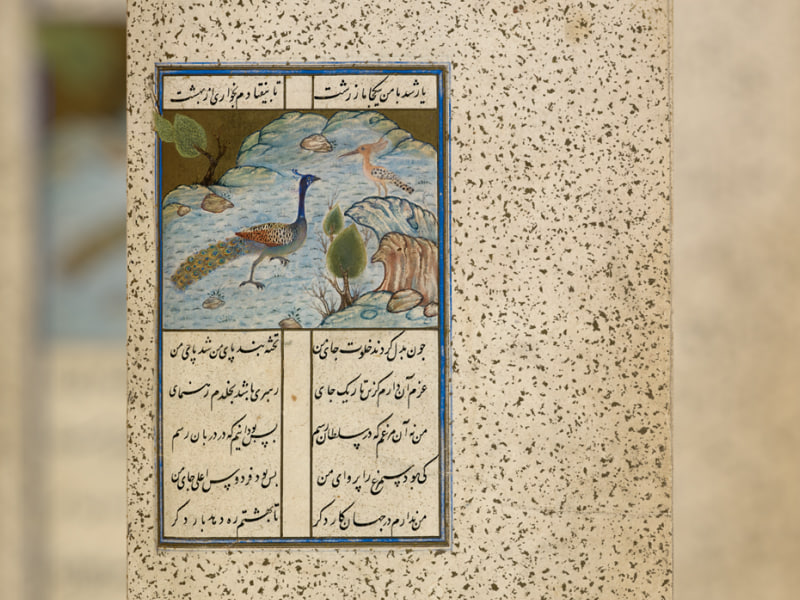The manuscript in London – a rare example of a media project

One of the great figures of world Sufi literature, Fariduddin Attar, has earned deep reverence throughout the Islamic world including the land of Turkestan thanks to his priceless spiritual legacy. Among his works, the Mantiq ut-Tayr holds a special place. This work is considered one of the most important masnavis concerning Sufi wisdom, spiritual self-perfection, and the soul’s journey toward understanding God.
A portion of an ancient manuscript copy of this work, transcribed in Herat in the 15th century, is currently preserved in the British Library in London (No. Add. 7735). This copy represents a unique treasure, not only historically but also spiritually. It is included in the Islamic Civilization Center of Uzbekistan’s media project “100 Ancient Manuscripts of Uzbekistan”.
This copy, transcribed in Herat during the Timurid period, reflects the high level of calligraphy, decorative traditions, paper quality, and writing style of its time. Its preservation in the British Library indicates the international recognition and significance of the work. At the same time, it prompts reflection on the fact that many rare works related to our national spiritual heritage are kept in foreign libraries for various reasons.
Currently, this manuscript in London holds special importance not only for researchers but also for the general public as a valuable source. Its preservation in manuscript form allows for the study of the original structure, style, and meaning, providing an authentic understanding of Attar’s intellectual world.
Attar and the value of spiritual heritage
Living among Sufi circles and adherents of mysticism, Fariduddin Attar was profoundly influenced by this spiritual path. He himself was a great shaykh and saint. He received the dervish cloak from the hands of Majduddin Baghdadi, known as the “shaykh of shaykhs”. The renowned Iranian literary scholar Sayyid Nafisi also regarded him as a follower of the Kubrawiyya Sufi order. Nevertheless, Attar is traditionally considered a disciple of Shaykh Ruknuddin in the spiritual path of Sufism. In essence, he was an Uwaysi, spiritually nurtured by the soul of the famed mystic Mansur Hallaj. Alisher Navoi, citing Jalaluddin Rumi, wrote about this:
“The light of Shaykh Mansur Hallaj manifested in the soul of Shaykh Fariduddin Attar one hundred and fifty years later and became his spiritual guide”. At the same time, Attar foretold the future greatness of Jalaluddin Rumi and gifted him his book Asrarnama.
Rumi’s acknowledgment “Attar was the soul, and Sanai his two eyes. We follow in the footsteps of Sanai and Attar” is no coincidence. Alisher Navoi also had deep reverence and admiration for Attar. It is said that he memorized Mantiq ut-Tayr at the age of five, was influenced by Attar’s poetry throughout his life, and eventually composed a response in the form of Lison ut-Tayr, referring to it as a “translation with an image.” In this work, Navoi likens Attar to the mythical bird Qaqnus, and himself to the offspring of Qaqnus.
Attar was an extremely prolific poet, leaving behind more than 50,000 poetic lines. His poetic divan, the rubai collection Mukhtarnama, and such masnavis as Mantiq ut-Tayr, Khusrawnama, Asrarnama, Ilahinama, Musibatnama, Bulbulnama, Ushturnama, Jawhar uz-Zat, as well as the hagiographic work Tazkirat al-Awliya, are among his most famous and celebrated literary contributions.
Attar’s works are primarily devoted to the exposition of Sufi truths. For this reason, he holds a prominent position in Sufi literature. After Uzbekistan gained independence, Najmiddin Komilov published a prose translation of the poet’s Ilahinama masnavi. The book includes introductory and concluding chapters that explore Attar’s life and creativity, his worldview, and the essence of his works. Meanwhile, Mirzo Kenjabek translated and published Tazkirat al-Awliya from Turkish.
Fariduddin Attar is considered one of the most distinguished rubai (quatrain) poets in Persian literary art. His Mukhtarnama contains 5,000 rubaiyat, though not all of them have survived to the present day. In the most recent edition published in Iran, including appendices, 2,279 rubaiyat are presented.
These quatrains, steeped in a mystical spirit and meaning, are, in a word, dedicated to glorifying God, extolling divine love in exalted tones, comprehending the essence of humanity, condemning the body, the ego, and the material world as veils on the path to perfection, describing the beloved in poetic terms, and expressing the hopes of union and the pain of separation.
Durdona Rasulova
P.S.: The article may be used provided that a link to the official website of the Center is included.
Most read

Over 100 experts from more than 20 countries of the world are in Tashkent!

The Center for Islamic Civilization – a global platform leading towards enlightenment

The museum of the Center for Islamic Civilization in Uzbekistan has been further enriched: unique artifacts from different parts of the world have been presented as gifts











